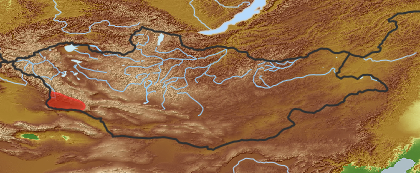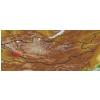| Class: | angiosperms |
| Order: | Lamiales |
| Family: | Lamiaceae |
| Genus: | Nepeta |
| Scientific name: | Nepeta pungens (Bunge) Benth. |
| Name acc. to: | Gubanov 1996, not in Grubov 1982/2001 |
| Comments: | Rare for Mongolia (Ebel & Rudaya 2002) |
| Link to Flora of China: | http://www.efloras.org/browse.aspx?flora_id=2&name_str=Nepeta+pungens |
| open map in a new window |  |
| Habitat: | Rocky and rubble slopes of foothills to midbelt of mountains, on takyrs in deserts, in saxaul thickets and dry river-beds (Plants of Central Asia, Vol. 5, 2002). |
| Habit (i)general appearance of a plant | |
| Smell & Touch: (i)General appearance of the plant. | odor (i)Plant with an obvious scent
|
| Parasite status: (i)Is the plant a half- or full parasite? | no parasite/saprophyte (i)Plant fully autonomous, leaves with chlorophyll
example: Most plants, Ranunculus  inherited by family Lamiaceae: no parasite/saprophyte inherited by family Lamiaceae: no parasite/saprophyte
|
| Water or terrestrial plant: (i)Where do the plants grow? | terrestrial (i)Plant grows on dry land
example: Orostachys spinosa  inherited by family Lamiaceae: terrestrial inherited by family Lamiaceae: terrestrial
|
| Leaf (i)expanded, usually photosynthetic organ of a plant (including phylloclades) | |
| Leaf development: (i)Structure and development of leaves. | flattened blade (i)Cross-section of lamina flat, plain  inherited by family Lamiaceae: flattened blade inherited by family Lamiaceae: flattened blade
common leaf (i)Green, often divided in blade and petiole
example: Cotoneaster  inherited by family Lamiaceae: common leaf inherited by family Lamiaceae: common leaf
with green leaves (i)Plant with green leaves  inherited by family Lamiaceae: with green leaves inherited by family Lamiaceae: with green leaves
|
| Leaf arrangement: (i)Arrangement of leaves at the stem. | opposite, opposite-decussate (i)Two leaves per node
example: Lamiaceae, e.g. Phlomis    inherited by family Lamiaceae: opposite, opposite-decussate inherited by family Lamiaceae: opposite, opposite-decussate
|
| Shape of blade: (i)Easy for simple leaves. In compound leaves use the general shape of leaflet. Always check the ground for largest leaves of a plant. To be worked out: how to handle pinnate leaves? | elliptic (including ovate and obovate) (i)Elliptic: broadest at the middle and narrower at the two equal ends; ovate: egg-shaped, attached at the broad end; obovate: attached at the narrower end
example: Limosella aquatica   inherited by genus Nepeta: elliptic (including ovate and obovate) inherited by genus Nepeta: elliptic (including ovate and obovate)
|
| Stipule: (i)Leaflets at the base of the petiole, these are smaller and of different shape. | none (i)Without stipules
example: Euphorbia, Ericaceae s.l.  inherited by family Lamiaceae: none inherited by family Lamiaceae: none
|
| Leaf veination: (i)Arrangement of the main veins of a leaf. | pinnate (i)One main vein, several side veins, sometimes inconspicuous
example: Cicerbita     inherited by family Lamiaceae: pinnate inherited by family Lamiaceae: pinnate
|
| Flower (i)reproductive portion of the plant, consisting of sepals, petals, stamens, and pistils | |
| Flower appearance and pollination: (i)General appearance of the flower. | attractive, animal-pollinated (i)attractive and coloured flowers, mostly large, attracting surely animals
example: Trollius, Rosa, Chamaerhodos  inherited by family Lamiaceae: attractive, animal-pollinated inherited by family Lamiaceae: attractive, animal-pollinated
|
| Perianth arrangement: (i)Attention: in some plants, flowers may be dimorphic in different ways (dioecious or gynodioecious). If flowers vary, record the characters of the most showy flowers. | double, different (i)Two types of perianth leaves, differently coloured (sepals: outer periant leaves, usually greenish, and petals: inner perianth leaves, usually coloured)
example: Parnassia    inherited by family Lamiaceae: double, different inherited by family Lamiaceae: double, different
|
| Flower symmetry: (i)Symmetry of the perianth leaves. Attention: to assess this character, look on sepals, petals and stamens, but neglect carpels and ovary. | zygomorphic (i)One axis of symmetry, monosymmetrical flowers
example: Pedicularis, Nepeta, Viola     inherited by family Lamiaceae: zygomorphic inherited by family Lamiaceae: zygomorphic
|
| Flower form: (i)common forms of flowers ? Veronica | bilabiate (i)Petals froming two lips, flower usually zygomorphic
example: Lamiaceae, Scrophulariaceae p.p.   inherited by family Lamiaceae: bilabiate inherited by family Lamiaceae: bilabiate
|
| Sepal number: (i)Number of sepal leaves (outer perianth leaves, calyx leaves, mostly greenish). Attention, this character applies only for flowers separated in sepals and petals, thus excluding most monocots. Be aware of the bracts (involucral leaves) of Asteraceae flowerheads, do not qualify these as sepals! Be also aware in Rosaceae is often an epicalyx developed, in this case count all parts. | 5 (i)
example: Polemonium  inherited by family Lamiaceae: 5 inherited by family Lamiaceae: 5
|
| Sepal fusion: (i)To which degree are the sepal leaves connected? Attention, this character applies only for flowers separated in sepals and petals, thus excluding most monocots. Be aware of the bracts (involucral leaves) of Asteraceae flowerheads, do not qualify these as sepals! | fused (i)Leaves united, only tips are free
example: Fabaceae, Silene    inherited by family Lamiaceae: fused inherited by family Lamiaceae: fused
|
| Petal / Tepal number: (i)Number of petal leaves (inner perianth leaves, usually coloured). | 5 (i)
example: Potentilla  inherited by family Lamiaceae: 5 inherited by family Lamiaceae: 5
|
| Petal / Tepal fusion: (i)To which degree are the petal leaves connected? Petals sympetalous. | fused (i)petal leaves united, only tips are free (gamopetalous, sympetalous)
example: Linnaea, Adenophora, Stellera  inherited by family Lamiaceae: fused inherited by family Lamiaceae: fused
|
| Spur: (i)A hollow, slender, sac-like appendage of the perianth leaves, storing nectar. | no spur (i)Flower without appendage
example: Peganum  inherited by family Lamiaceae: no spur inherited by family Lamiaceae: no spur
|
| Stamen number: (i)Attention: We ask for the reproductive organs of the flower dispersing pollen. Count only fully fertile stamens, not staminodia (e.g. Parnassia). | 4 (i)Extremely rare, may be absent
example: Plantago  inherited by genus Nepeta: 4 inherited by genus Nepeta: 4
|
| Stamen fusion: (i)To which degree are the stamens fused? Attention: Whereas the pollen sacs itself are often free., their stalks (filaments) may be fused. Here, we count them as fused if they are together over at least one thirth of their length. | free (i)Stamens with separate bases
example: Malus  inherited by family Lamiaceae: free inherited by family Lamiaceae: free
|
| Pistil number: (i)Number of pistils (female floral organs: style, if developed; stigma and carpels/ovary together build the pistil). | 1 (i)One carpel, but clearly one stigma
example: Pyrola, Primula, Alyssum  inherited by family Lamiaceae: 1 inherited by family Lamiaceae: 1
|
| Carpel number: (i)Number of carpels (carpel: forming a simple pistil or part of a compound pistil, modified leaf). | 2  inherited by family Lamiaceae: 2 inherited by family Lamiaceae: 2
|
| Carpel fusion: (i)To which degree are the carpels (modified leaf forming simple pistil or part of a compound pistil) fused. | fused (i)Carpels united into an ovary, only styles are free
example: Malus, Berberis  inherited by family Lamiaceae: fused inherited by family Lamiaceae: fused
|
| Stigma number per style: (i)Number of stigmas per style. | 2 (i)Two stigmas, resulting from two fused carpels with or without developed style   inherited by family Lamiaceae: 2 inherited by family Lamiaceae: 2
|
| Ovary position: (i)For entirely or partly fused carpels, describe their position in relation to the insertion point of perianth leaves (best done by doing a longitudinal section of a flower). | superior (hypogynous) (i)Base of carpels attached above insertion point of perianth leaves, carpels free or fused
example: Delphinium, Anemone    inherited by family Lamiaceae: superior (hypogynous) inherited by family Lamiaceae: superior (hypogynous)
|
| Sex: (i)Distribution of male and female organs among flowers, only most commonly cases. | bisexual, hermaphrodite (i)All or nearly all flowers of a plant with male and female parts
example: Haplophyllum, Chenopodium  inherited by family Lamiaceae: bisexual, hermaphrodite inherited by family Lamiaceae: bisexual, hermaphrodite
|
| Inflorescence (i)flowering part of a plant, describes the arrangement of the flowers on the flowering axis | |
| Inflorescence: (i)Structure of the inflorescence. | Flowers in inflorescence (i)No solitary flowers
|
| Appearance: (i)Outer look of the inflorescence. | terminal (i)Inflorescence is the highest point of the plant and may consist of a single flower only
example: Cypripedium, Rhaponticum, Ligularia sibirica, Echinops
|
| Inflorescence type: (i)Types of inflorescence. Attention: We here ask for the botanical nomenclature of inflorescences, which is sufficiently complicated. Tick only, if you are certain, or tick all inflorescence types that appear similar of these of the plant in question. | spike (spadix) (i)All flowers sessile and crowded along a main axis, there may be several spikes on a shoot; sometimes axis thickened (spadix)
example: Plantago, Carex vesicaria, Vicia, Typha (spadix)  
raceme (i)Stalked flowers arranged along a simple main axis, often one by one in the axils of leaves, maturing from bottom upwards
example: Aconitum barbatum 
|
| Fruit (i)the seed bearing organ, with or without adnate parts; a ripened ovary and any other structures which are attached and ripen with it. Aggregate fruits are handled like simple fruits for determination. | |
| Consistency: (i)Fleshy fruits or dry fruits, see dispersal adaptations for further classification. | dry (i)With a dry outer shell, no fleshy parts, but seed (embryo) could be edible  inherited by family Lamiaceae: dry inherited by family Lamiaceae: dry
|
| Type of fruit: (i)Common fruit types (including pseudocarp). | Indehiscent fruits  inherited by family Lamiaceae: Indehiscent fruits inherited by family Lamiaceae: Indehiscent fruits
Solitary fruits (i)     inherited by family Lamiaceae: Solitary fruits inherited by family Lamiaceae: Solitary fruits
nut or nutlet (i)Dry fruit with a single, hard stone inside (and usually a large often edible embryo)   inherited by family Lamiaceae: nut or nutlet inherited by family Lamiaceae: nut or nutlet
|
| Opening of fruit: (i)Mode of dehiscence at maturity to release seeds. | not opening / indehiscent (i)Fruits remain closed at maturity and disperse with seeds inside
example: Corylus (nut), Vaccinium (berry)  inherited by family Lamiaceae: not opening / indehiscent inherited by family Lamiaceae: not opening / indehiscent
|
| Splitting of fruit: (i)Is a solitary fruit splitting into fruitlets? The fruit splits into separate one-seeded segments at maturity (schizocarp). | splitting  inherited by family Lamiaceae: splitting inherited by family Lamiaceae: splitting
in 4 parts (i)
example: Boraginaceae, Lamiaceae   inherited by family Lamiaceae: in 4 parts inherited by family Lamiaceae: in 4 parts
|
| Seed number: (i)Estimate the number of seeds per fruit, if recognizable seeds are in the fruit (in rare cases a fruit may contain one seeded nuts: rose hip, carex). | 2-6 (i)2-6 single seeds, well recognizable
example: Crataegus: few-seeded berry
|
| Hairs | |
| Has hairs?: | no hairs, glabrous
|
| Shoot/Stem (i)a young stem or branch | |
| Cross section: (i)Shape of the cross section of a stem or shoot (look at first to second year shoots). | square / quadrate (i)Stem or shoot with 4 angles  inherited by family Lamiaceae: square / quadrate inherited by family Lamiaceae: square / quadrate
|
| Root / shoot below ground (i)plant part below ground (in most cases), including below ground shoots, without leaves | |
| Root type: (i)Organisation of the roots. | allorhizous (i)Plant with a conspicuous tap root, one larger tap root with side roots
example: Dicotyledonae  inherited by order Lamiales: allorhizous inherited by order Lamiales: allorhizous
|
| Distribution (i)region where the plant is likely to be found | |
| Distribution (Veg. Zones): (i)acc. to Grubov 1952 | Dzungarian Gobi (i)In distribution data often named as '14' 
acc. to: Gubanov 1996 |
| Plant Use | |
| General Use: | other  inherited by family Lamiaceae: other inherited by family Lamiaceae: other
|